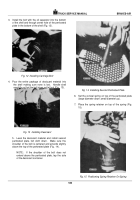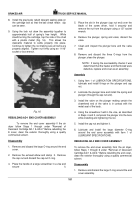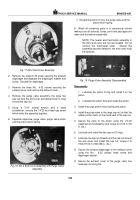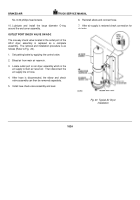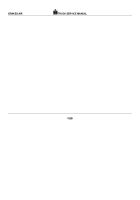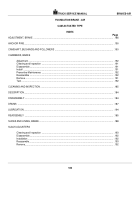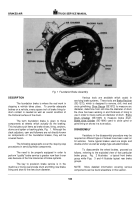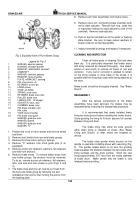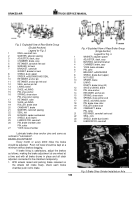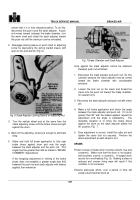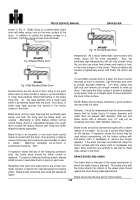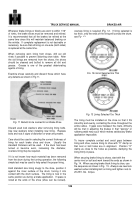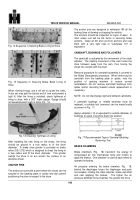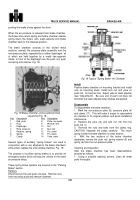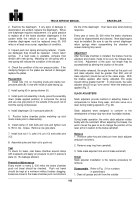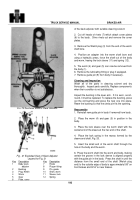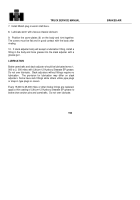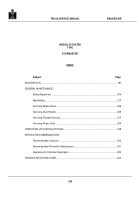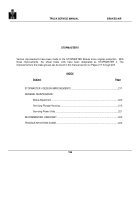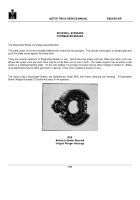TM-5-3805-254-14-P-2 - Page 192 of 894
TRUCK SERVICE MANUAL
BRAKES-AIR
shown in Fig. 9.
Brake lining on a bellmouthed brake
drum will make contact only on the inner surface of the
drum.
In addition to cutting the braking surface to a
minimum, it will also cause uneven and rapid wear.
Fig. 8 Bulged Brake Drum
Fig. 9 Bell-Mouthed Brake Drum
Scored drums are the result of worn lining to the point
where drum to shoe contact is made or an accumulation
of small steel particles imbed themselves in the brake
lining (Fig.
10).
The steel particles form a tough scale
which is sometimes harder than the drum.
As a result, in
either case deep grooves are formed in the friction
surface of the drum.
Brake drum scoring never improves but continually gets
worse until both the lining and the brake drum are
useless.
Attempting to reline brakes without turning
scored brake drums is impractical because the rough
drum surface will quickly destroy new lining and make
effective braking impossible.
Brake lining in an eccentric or out-round drum cannot
make full contact with the drum, thus resulting in rapid or
uneven lining wear and could even cause brakes to seize
or chatter.
Maximum allowable out-of-round or
eccentricity should be .
004".
If inspection shows that any of the foregoing conditions
exist, the brake drum should be either turned or
replaced.
To assure a balanced braking system, always
install turned or new brake drums in pairs on each axle.
Remember that each time brake drums are turned, less
metal remains to absorb the heat developed by braking
action.
Brake drums containing less metal will operate at
higher
Fig. 10 Scored Brake Drum
temperature.
As a result, brake fade, slow recovery and
erratic action will be more noticeable.
Also, the
extremely high temperatures will not only shorten lining
life, but also can cause heat checks and cracks to form
on the inner surfaces of the drums. These conditions will
become progressively worse until finally the drums will
fail.
To recondition a brake drum in a lathe, the drum must be
mounted so that it is centered.
Use the proper size cone
to provide accurate centering.
Turn drum, taking only
light cuts and remove just enough material to clean up
drum.
Then grind the finish surface if grinder is available
or use emery cloth on a straight piece of wood and polish
the drum friction surface.
NOTE: Brake drums that are otherwise in good condition
can be turned in a lathe.
However, it must be remembered that the recommended
rebore limit for brake drums 14 inches diameter and
under must not exceed .060" diameter (total cut) and
brake drums with a diameter over 14" may not be
increased more than .080" diameter (total cut).
Brake drums should be cleaned thoroughly with a steam
cleaner or hot water.
Do not use a solvent which leaves
an oily residue. If inspection shows the drums may be
used without remachining, rub the friction surface with
fine emery cloth or sandpaper to remove any foreign
deposits.
If the drum has been reconditioned, clean the
friction surface with fine emery cloth or sandpaper and
wash. Next, examine very carefully to see that no metal
chips remain in the drum.
BRAKE SHOES AND LINING
The brake shoe is that part of the brake mechanism to
which the brake lining is attached.
The brake shoe with
the lining retards the rotation of the wheel when forced
against the drum during brake applications.
Brake shoes must be true and of correct radius.
188
Back to Top

